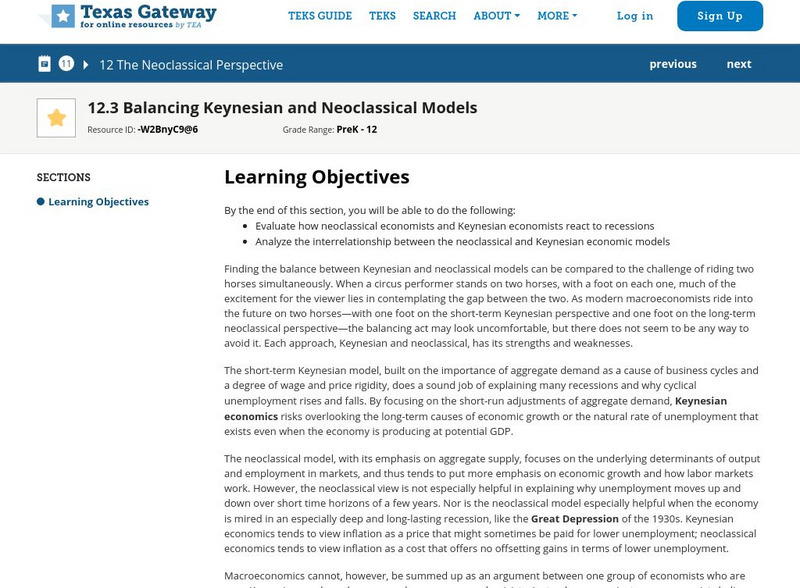Khan Academy
Khan Academy: Market Equilibrium
The actual price you see in the world is a balancing act between supply and demand.
Texas Education Agency
Texas Gateway: Ch. 12: The Policy Implications of the Neoclassical Perspective
By the end of this section, you will be able to do the following: Discuss why and how inflation expectations are measured, Analyze the impacts of fiscal policy and monetary policy on aggregate supply and aggregate demand. Explain the...
Texas Education Agency
Texas Gateway: Chapter 12: Balancing Keynesian and Neoclassical Models
By the end of this section, you will be able to do the following: Evaluate how neoclassical economists and Keynesian economists react to recessions and Analyze the interrelationship between the neoclassical and Keynesian economic models.
University of Minnesota
University of Minnesota: 2.1 Factors of Production: Principles of Economics
The three factors of production-labor, capital, and natural resources. Explain the role of technology and entrepreneurs in the utilization of the economy's factors. Labor is the human effort that can be applied to the production of goods...
Khan Academy
Khan Academy: Keynes' Law and Say's Law in the Ad/as Model
Compare Keynes's and Say's law in the context of aggregate supply and demand.
Khan Academy
Khan Academy: Lesson Summary: Changes in the Ad as Model in the Short Run
In this lesson summary review and remind yourself of the key terms and graphs related to changes in the AD-AS model. Topics include AD shocks, such as changes in consumption, investment, government spending, or net exports, and supply...
Khan Academy
Khan Academy: Lesson Overview: Consumer and Producer Surplus
This lesson introduced the basics of a branch of economics known as welfare economics, which is interested in how the allocation of resources affects well-being. The most important concepts used in welfare analysis are total surplus and...
Khan Academy
Khan Academy: Market Equilibrium, Disequilibrium, and Changes in Equilibrium
For this lesson summary review and remind yourself of the key terms and graphs used in the analysis of markets. Topics include how to use a market model to predict how price and quantity change in a market when demand changes, supply...
Khan Academy
Khan Academy: Determinants of Price Elasticity and the Total Revenue Rule
Practice what you've learned about the relationship between price elasticity of demand and total revenue in this exercise. This resource is designed as a review for the AP Microeconomics Test or a college-level microeconomics course.
Khan Academy
Khan Academy: The Building Blocks of Keynesian Analysis
Keynesian economics focuses on explaining why recessions and depressions occur and offering a policy prescription for minimizing their effects. The Keynesian view of recession is based on two key building blocks: recessions occur when...
Khan Academy
Khan Academy: Elasticity in the Long Run and Short Run
The elasticity of supply or demand can vary based on the length of time you care about. This resource is designed for students who are taking a college-level microeconomics course.
Khan Academy
Khan Academy: Law of Supply
If the price of something goes up, companies are willing (and able) to produce more of it.
University of Colorado
University of Colorado: Summary Table of Market Equilibrium
Chart that shows what happens to equilibrium price and quantity when both supply and demand remain constant or shift.
Khan Academy
Khan Academy: Price Ceilings and Price Floors
This article discusses how quantity demanded react to artificial constraints on price.
Other
South Western Learning: Oligopoly/monopolistic Competition: Kinked Demand Curve
This South-Western College Publishing website describes a situation in which oligopolistic firms vie for competition among consumers.
Council for Economic Education
Econ Ed Link: Henry Ford and the Model T: A Case Study in Productivity (Part 3)
Henry Ford's use of mass production strategies to manufacture the Model T revolutionized industrial manufacturing. This 3-part learning unit provides students with the story of Henry Ford and the Model T from an economics perspective....
Council for Economic Education
Econ Ed Link: The Prices Are Changing
This lesson will help students to understand how markets are created by the interaction of buyers and sellers, what demand and supply are, what equilibrium price is, and how demand and supply interact with price changes.
Khan Academy
Khan Academy: Changes in Equilibrium
Practice finding a new equilibrium price and quantity when supply changes, demand changes, or both supply and demand are changing simultaneously.`This resource is designed as a review for the AP Microeconomics Test or a college-level...
Council for Economic Education
Econ Ed Link: What Do People Want to Wear?
To stay in business, fashion merchandisers must be able to anticipate what consumers want. By looking at different retail websites, students will look to anticipate what consumers are demanding. Students will then go through the market...
Council for Economic Education
Econ Ed Link: Marketplace: Price Increase or Price Gouging?
Students learn about price-gouging. Using a hypothetical post-disaster example, they will learn more about supply and demand, as well as the complexities associated with price increases in a supply-constrained market.
Council for Economic Education
Econ Ed Link: What Happened to Railroads?
Between the Civil War and World War II, railroads were one of the nation's most important businesses and an integral part of people's lives. In this lesson, students assume the role of detectives investigating why the rail companies...
Texas Education Agency
Texas Gateway: Ap Macroeconomics: Chapter 8: The Confusion Over Inflation
By the end of this section, you will be able to do the following: Explain how inflation can cause redistribution of purchasing power, Identify ways inflation can blur the perception of supply and demand, and Explain the economic benefits...
Council for Economic Education
Econ Ed Link: Collecting for Fun . . . And Profit?
Art, baseball cards, coins, comic books, dolls, jewelry and stamps are just a few examples of the many things people collect. While some people collect for fun, others hope to profit. For this lesson, young scholars explore how supply...
Council for Economic Education
Econ Ed Link: What Causes Inflation?
This lesson plan explores different types of inflation and terms associated with this economic concept. You may have heard relatives talk about the good old days when a dollar would buy something. What happened to that dollar? Why won't...




















